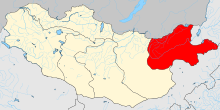

Sechen Khan, also spelled Setsen Khan (Mongolian: ᠰᠡᠴᠡᠨ
ᠬᠠᠨ; Cyrillic: Сэцэн хан; Chinese: 車臣汗), refers to the territory as well as the Chingizid dynastic rulers of the Secen Khanate. It was one of four Khalka khanates that emerged from remnants of the Mongol Empire after the death of Dayan Khan's son Gersenji Khongtaiji in 1549.
The first Sechen Khan Sholoi was a gread-grand son of Gersenji Khongtaiji. In the early 1630s, the 5th Dalai Lama bestowed on him the title of "Gegeen Setsen Khan" (Гэгээн сэцэн хан).[1]
In 1688, Ömkhei, the 4th Sechen Khan fled to Xilingol where he pledged fealty to the Kangxi Emperor of the Qing China in return for protection against the invading Dzungar Mongolian forces under Galdan Boshugtu Khan. On 3 June 1691,[2] Ömkhei attended the Dolonnuur Assembly together with Tusheet Khan, Zasagt Khan and more than 500 noyans and taijis. Since then, the Khalkha Mongols in Outer Mongolia submitted to the Qing dynasty.[3] The three khanates, Sechen Khan, Tüsheet Khan and Zasagt Khan, became three provincial subdivisions or aimags of Qing China. In the next year, Khalka was divided into three zams (зам), the area of Sechen Khan aimag was named "Khalka Left Zam" (Mongolian: Халхын зүүн зам, Chinese: 喀爾喀東路).[4] In 1725, Qing China created a fourth aimag, Sain Noyon.[5] Since 1728, each aimag was governed by aimag congress chigulgan (чуулган) comprising the lords of the khoshuns; the chigulgan daruga (чуулган дарга - official presiding the congress) was appointed from the khoshun lords by the Qing government. the congress of Sechen Khan aimag was called the "Kherlen Bars khotod chuulgan" (Хэрлэн Барс хотод чуулган, 克魯倫巴爾和屯盟), which was held every three years in Kherlen Bars.
In 1923, following the Mongolian Revolution of 1921, the Sechen Khan aimag was renamed Khan Khentii Uulyn aimag (Хан Хэнтий уулын аймаг),[6] which named after the Khan Khentii Mountain.[4] In 1930, the four aimags were divided into the present day 21 smaller aimags, which were subdivided into sums.
- ^ "Шолой Сэцэн хан". Монголын түүх (in Mongolian).
- ^ Chapter Three ASSEMBLIES, From the book Common Ground
- ^ "Долоннуурын чуулган". Монголын түүх (in Mongolian).
- ^ a b "Сэцэн хан аймаг". Монголын түүх (in Mongolian).
- ^ Sanders, Alan A. K. (2010). Historical Dictionary of Mongolia. Scarecrow Press. p. 380. ISBN 978-0810874527.
- ^ Li, Narangoa; Cribb, Robert (2014). Historical Atlas of Northeast Asia, 1590-2010: Korea, Manchuria, Mongolia, Eastern Siberia. Columbia University Press. p. 169. ISBN 9780231537162.